Historical Change and Ecological Risk of Potentially Toxic Elements in the Lake Sediments from North Aral Sea, Central Asia
Abstract
1. Introduction
2. Materials and Methods
2.1. Geographic Background
2.2. Sampling and Laboratory Methods
2.3. Potential Ecological Risk Index (PERI)
2.4. Geo-Accumulation Index (Igeo)
3. Results
3.1. Summary Statistics for 12 Environmental Parameters
3.2. Vertical Distribution of Environmental Parameters
4. Discussion
5. Conclusions
- The contents of PTEs in the lake sediments from North Aral Sea changed abruptly around 1970 AD, which is associated with the anthropogenic intensification in the basin;
- After 1975 AD, with the exception of as (Igeo < 1), the geo-accumulation index of PTEs (V, Cr, Zn, Co, Pb, Ni, C, and Cd) was greater than 1, reflecting a moderately polluted status;
- Before 1970 AD, the total ecological risk index was lower than 150, indicating a low risk, but since 1970, the total ecological risk index has exceeded 150, which represents a moderate risk.
Supplementary Materials
Author Contributions
Funding
Acknowledgments
Conflicts of Interest
References
- Qi, J.; Bobushev, T.S.; Kulmatov, R.; Groisman, P.; Gutman, G. Addressing global change challenges for Central Asian socio-ecosystems. Front. Earth Sci. 2012, 6, 115–121. [Google Scholar] [CrossRef]
- Li, Z.; Chen, Y.; Li, W.; Deng, H.; Fang, G. Potential impacts of climate change on vegetation dynamics in Central Asia. J. Geophys. Res. 2015, 120, 12345–12356. [Google Scholar] [CrossRef]
- Saiko, T.A.; Zonn, I.S. Irrigation expansion and dynamics of desertification in the Circum-Aral region of Central Asia. Appl. Geogr. 2000, 20, 349–367. [Google Scholar] [CrossRef]
- Spoor, M. The aral sea Basin crisis: Transition and environment in former soviet central asia. Dev. Chang. 1998, 29, 409–435. [Google Scholar] [CrossRef]
- Micklin, P.P. Desiccation of the Aral Sea: A Water Management Disaster in the Soviet Union. Science 1988, 241, 1170–1176. [Google Scholar] [CrossRef]
- Mirabdullayev, I.M.; Joldasova, I.M.; Mustafaeva, Z.A.; Kazakhbaev, S.; Lyubimova, S.A.; Tashmukhamedov, B.A. Succession of the ecosystems of the Aral Sea during its transition from oligohaline to polyhaline water body. J. Mar. Syst. 2004, 47, 101–107. [Google Scholar] [CrossRef]
- Micklin, P. The past, present, and future Aral Sea. Lakes Reserv. Res. Manag. 2010, 15, 193–213. [Google Scholar] [CrossRef]
- Williams, W.D.; Aladin, N.V. The Aral Sea: Recent limnological changes and their conservation significance. Aquat. Conser. 1991, 1, 3–23. [Google Scholar] [CrossRef]
- Crighton, E.J.; Barwin, L.; Small, I.; Upshur, R. What have we learned? A review of the literature on children’s health and the environment in the Aral Sea area. Int. J. Public Health 2011, 56, 125–138. [Google Scholar] [CrossRef]
- Ataniyazova, O.A. Health and ecological consequences of the Aral Sea crisis. In Proceedings of the 3rd World Water Forum, Regional Cooperation in Shared Water Resources in Central Asia, Kyoto, Japan, 18 March 2003. [Google Scholar]
- Glazovsky, N.F. The Aral Sea Basin; The United Nations University Press: Tokyo, Japan, 1995. [Google Scholar]
- Shen, H.; Abuduwaili, J.; Samat, A.; Ma, L. A review on the research of modern aeolian dust in Central Asia. Arab. J. Geosci. 2016, 9, 625. [Google Scholar] [CrossRef]
- Abuduwaili, J. Saline dust storms and their ecological impacts in arid regions. J. Arid Land 2010, 2, 144–150. [Google Scholar] [CrossRef]
- Small, I.; Meer, J.v.d.; Upshur, R.E.G. Acting on an environmental health disaster: The case of the aral sea. Environ. Health Persp. 2001, 109, 547–549. [Google Scholar] [CrossRef] [PubMed]
- Zetterstrom, R. Child health and environmental pollution in the Aral Sea region in Kazakhstan. Acta Paediatrica 1999, 429, 49–54. [Google Scholar] [CrossRef] [PubMed]
- Chen, F.-H.; Chen, J.-H.; Holmes, J.; Boomer, I.; Austin, P.; Gates, J.B.; Wang, N.-L.; Brooks, S.J.; Zhang, J.-W. Moisture changes over the last millennium in arid central Asia: A review, synthesis and comparison with monsoon region. Quat. Sci. Rev. 2010, 29, 1055–1068. [Google Scholar] [CrossRef]
- Cretaux, J.-F.; Letolle, R.; Bergé-Nguyen, M. History of Aral Sea level variability and current scientific debates. Glob. Planet. Chang. 2013, 110, 99–113. [Google Scholar] [CrossRef]
- Sorrel, P.; Popescu, S.-M.; Head, M.J.; Suc, J.P.; Klotz, S.; Oberhänsli, H. Hydrographic development of the Aral Sea during the last 2000 years based on a quantitative analysis of dinoflagellate cysts. Paleogeogr. Paleoclimatol. Paleoecol. 2006, 234, 304–327. [Google Scholar] [CrossRef]
- Boomer, I.; Aladin, N.; Plotnikov, I.; Whatley, R. The palaeolimnology of the Aral Sea: A review. Quat. Sci. Rev. 2000, 19, 1259–1278. [Google Scholar] [CrossRef]
- Jin, Q.; Wei, J.; Yang, Z.-L.; Lin, P. Irrigation-Induced Environmental Changes around the Aral Sea: An Integrated View from Multiple Satellite Observations. Remote Sens. 2017, 9, 900. [Google Scholar] [CrossRef]
- Singh, A.; Behrangi, A.; Fisher, J.B.; Reager, J.T. On the Desiccation of the South Aral Sea Observed from Spaceborne Missions. Remote Sens. 2018, 10, 793. [Google Scholar] [CrossRef]
- Peneva, E.L.; Stanev, E.V.; Stanychni, S.V.; Salokhiddinov, A.; Stulina, G. The recent evolution of the Aral Sea level and water properties: Analysis of satellite, gauge and hydrometeorological data. J. Mar. Syst. 2004, 47, 11–24. [Google Scholar] [CrossRef]
- Shibuo, Y.; Jarsjö, J.; Destouni, G. Hydrological responses to climate change and irrigation in the Aral Sea drainage basin. Geophys. Res. Lett. 2007, 34, 34. [Google Scholar] [CrossRef]
- Schettler, G.; Oberhänsli, H.; Stulina, G.; Djumanov, J.H. Hydrochemical water evolution in the Aral Sea Basin. Part II: Confined groundwater of the Amu Darya Delta – Evolution from the headwaters to the delta and SiO2 geothermometry. J. Hydrol. 2013, 495, 285–303. [Google Scholar] [CrossRef]
- Schettler, G.; Oberhänsli, H.; Stulina, G.; Mavlonov, A.A.; Naumann, R. Hydrochemical water evolution in the Aral Sea Basin. Part I: Unconfined groundwater of the Amu Darya Delta-Interactions with surface waters. J. Hydrol. 2013, 495, 267–284. [Google Scholar] [CrossRef]
- Tornqvist, R.; Jarsjo, J.; Karimov, B. Health risks from large-scale water pollution: Trends in Central Asia. Environ. Int. 2011, 37, 435–442. [Google Scholar] [CrossRef]
- Rosen, M.R.; Crootof, A.; Reidy, L.; Saito, L.; Nishonov, B.; Scott, J.A. The origin of shallow lakes in the Khorezm Province, Uzbekistan, and the history of pesticide use around these lakes. J. Paleolimnol. 2018, 59, 201–219. [Google Scholar] [CrossRef]
- Rzymski, P.; Klimaszyk, P.; Niedzielski, P.; Marszelewski, W.; Borowiak, D.; Nowiński, K.; Baikenzheyeva, A.; Kurmanbayev, R.; Aladin, N. Pollution with trace elements and rare-earth metals in the lower course of Syr Darya River and Small Aral Sea, Kazakhstan. Chemosphere 2019, 234, 81–88. [Google Scholar] [CrossRef]
- Ke, X.; Gui, S.; Huang, H.; Zhang, H.; Wang, C.; Guo, W. Ecological risk assessment and source identification for heavy metals in surface sediment from the Liaohe River protected area, China. Chemosphere 2017, 175, 473–481. [Google Scholar] [CrossRef]
- Wang, Y.; Yang, L.; Kong, L.; Liu, E.; Wang, L.; Zhu, J. Spatial distribution, ecological risk assessment and source identification for heavy metals in surface sediments from Dongping Lake, Shandong, East China. Catena 2015, 125, 200–205. [Google Scholar] [CrossRef]
- Yi, Y.; Yang, Z.; Zhang, S. Ecological risk assessment of heavy metals in sediment and human health risk assessment of heavy metals in fishes in the middle and lower reaches of the Yangtze River basin. Environ. Pollut. 2011, 159, 2575–2585. [Google Scholar] [CrossRef]
- Liu, D.; Abuduwaili, J.; Wang, L. Salt dust storm in the Ebinur Lake region: Its 50-year dynamic changes and response to climate changes and human activities. Nat. Hazards 2015, 77, 1069–1080. [Google Scholar] [CrossRef]
- Abuduwailil, J.; Zhaoyong, Z.; Fengqing, J. Evaluation of the pollution and human health risks posed by heavy metals in the atmospheric dust in Ebinur Basin in Northwest China. Environ. Sci. Pollut. Res. 2015, 22, 14018–14031. [Google Scholar] [CrossRef] [PubMed]
- Issanova, G.; Abuduwaili, J.; Galayeva, O.; Semenov, O.; Bazarbayeva, T. Aeolian transportation of sand and dust in the Aral Sea region. Int. J. Environ. Sci. Technol. 2015, 12, 3213–3224. [Google Scholar] [CrossRef]
- Glazovsky, N.F. The salt balance of the aral sea. GeoJournal 1995, 35, 35–41. [Google Scholar] [CrossRef]
- Gaybullaev, B.; Chen, S.-C.; Kuo, Y.-M. Large-scale desiccation of the Aral Sea due to over-exploitation after 1960. J Mt. Sci. 2012, 9, 538–546. [Google Scholar] [CrossRef]
- Micklin, P. Aral Sea Basin Water Resources and the Changing Aral Water Balance. In The Aral Sea: The Devastation and Partial Rehabilitation of a Great Lake; Micklin, P., Aladin, N.V., Plotnikov, I., Eds.; Springer: Berlin/Heidelberg, Germany, 2014; pp. 111–135. [Google Scholar]
- Zonn, I.S.; Glantz, M.H.; Kostianoy, A.G.; Kosarev, A.N. A. In The Aral Sea Encyclopedia; Zonn, I.S., Glantz, M.H., Kostianoy, A.G., Kosarev, A.N., Eds.; Springer: Berlin/Heidelberg, Germany, 2009; pp. 7–48. [Google Scholar]
- Cretaux, J.F.; Kostianoy, A.; Bergé-Nguyen, M.; Kouraev, A. Present-Day Water Balance of the Aral Sea Seen from Satellite. In Remote Sensing of the Asian Seas; Barale, V., Gade, M., Eds.; Springer International Publishing: Cham, Switzerland, 2019; pp. 523–539. [Google Scholar]
- Plotnikov, I.S.; Ermakhanov, Z.K.; Aladin, N.V.; Micklin, P. Modern state of the Small (northern) Aral Sea fauna. Lakes Reserv. Res. Manag. 2016, 21, 315–328. [Google Scholar] [CrossRef]
- Aladin, N.V.; Gontar, V.I.; Zhakova, L.V.; Plotnikov, I.S.; Smurov, A.O.; Rzymski, P.; Klimaszyk, P. The zoocenosis of the Aral Sea: Six decades of fast-paced change. Environ. Sci. Pollut. Res. 2019, 26, 2228–2237. [Google Scholar] [CrossRef]
- Xie, X.; Yan, M.; Wang, C.; Li, L.; Shen, H. Geochemical standard reference samples GSD 9–12, GSS 1–8 and GSR 1–6. Geostand. Newsl. 1989, 13, 83–179. [Google Scholar] [CrossRef]
- Hakanson, L. An ecological risk index for aquatic pollution control. A sedimentological approach. Water Res. 1980, 14, 975–1001. [Google Scholar] [CrossRef]
- Lin, Q.; Liu, E.; Zhang, E.; Li, K.; Shen, J. Spatial distribution, contamination and ecological risk assessment of heavy metals in surface sediments of Erhai Lake, a large eutrophic plateau lake in southwest China. Catena 2016, 145, 193–203. [Google Scholar] [CrossRef]
- Kempter, H.; Krachler, M.; Shotyk, W.; Zaccone, C. Major and trace elements in Sphagnum moss from four southern German bogs, and comparison with available moss monitoring data. Ecol. Indic. 2017, 78, 19–25. [Google Scholar] [CrossRef]
- Huang, K.; Ma, L.; Abuduwaili, J.; Liu, W.; Issanova, G.; Saparov, G.; Lin, L. Human-Induced Enrichment of Potentially Toxic Elements in a Sediment Core of Lake Balkhash, the Largest Lake in Central Asia. Sustainability 2020, 12, 4717. [Google Scholar] [CrossRef]
- Zhang, J.; Deng, H.; Wang, D.; Chen, Z.; Xu, S. Toxic heavy metal contamination and risk assessment of street dust in small towns of Shanghai suburban area, China. Environ. Sci. Pollut. Res. 2013, 20, 323–332. [Google Scholar] [CrossRef] [PubMed]
- Karbassi, A.R.; Monavari, S.M.; Nabi Bidhendi, G.R.; Nouri, J.; Nematpour, K. Metal pollution assessment of sediment and water in the Shur River. Environ. Monit. Assess. 2007, 147, 107. [Google Scholar] [CrossRef] [PubMed]
- Adamo, P.; Arienzo, M.; Imperato, M.; Naimo, D.; Nardi, G.; Stanzione, D. Distribution and partition of heavy metals in surface and sub-surface sediments of Naples city port. Chemosphere 2005, 61, 800–809. [Google Scholar] [CrossRef]
- Callaway, J.; DeLaune, R.; Patrick, W., Jr. Chernobyl 137Cs used to determine sediment accretion rates at selected northern European coastal wetlands. Limnol. Oceanogr. 1996, 41, 444–450. [Google Scholar] [CrossRef]
- Abbasi, A. 210Pb and 137Cs based techniques for the estimation of sediment chronologies and sediment rates in the Anzali Lagoon, Caspian Sea. J. Radioanal. Nucl. Chem. 2019, 322, 319–330. [Google Scholar] [CrossRef]
- Pennington, W.; Tutin, T.G.; Cambray, R.S.; Fisher, E.M. Observations on Lake Sediments using Fallout 137Cs as a Tracer. Nature 1973, 242, 324–326. [Google Scholar] [CrossRef]
- Blais, J.M.; Kalff, J.; Cornett, R.J.; Evans, R.D. Evaluation of 210 Pb dating in lake sediments using stable Pb, Ambrosia pollen, and 137 Cs. J. Paleolimnol. 1995, 13, 169–178. [Google Scholar] [CrossRef]
- Liu, S.; Narentuya; Xia, B.; Chu, G.; Tian, M. Using 210Pbuns and 137Cs to date recent sediment cores from the Badain Jaran Desert, Inner Mongolia, China. Quat. Geochronol. 2012, 12, 30–39. [Google Scholar] [CrossRef]
- Swanson, S.K.; Bahr, J.M.; Schwar, M.T.; Potter, K.W. Two-way cluster analysis of geochemical data to constrain spring source waters. Chem. Geol. 2001, 179, 73–91. [Google Scholar] [CrossRef]
- Iqbal, M.; Khan, S.M.; Azim Khan, M.; Ahmad, Z.; Ahmad, H. A novel approach to phytosociological classification of weeds flora of an agro-ecological system through Cluster, Two Way Cluster and Indicator Species Analyses. Ecol. Indic. 2018, 84, 590–606. [Google Scholar] [CrossRef]
- Xu, X.-W.; Qiang, X.-K.; Fu, C.-F.; Zhao, H.; Chen, T.; Sun, Y.-F. Characteristics of frequency-dependent magnetic susceptibility in Bartington MS 2 and Kappabridge MFK 1-FA, and its application in loess-paleosol, red clay and lacustrine sediments. Chin. J. Geophys. 2012, 55, 197–206. (In Chinese) [Google Scholar]
- Hu, S.; Deng, C.; Appel, E.; Verosub, K.L. Environmental magnetic studies of lacustrine sediments. Chin. Sci. Bull. 2002, 47, 613–616. [Google Scholar] [CrossRef]
- Ma, L.; Abuduwaili, J.; Liu, W. Environmentally sensitive grain-size component records and its response to climatic and anthropogenic influences in Bosten Lake region, China. Sci. Rep. 2020, 10, 942. [Google Scholar] [CrossRef] [PubMed]
- Ma, L.; Wu, J.; Abuduwaili, J.; Liu, W. Geochemical Responses to Anthropogenic and Natural Influences in Ebinur Lake Sediments of Arid Northwest China. PLoS ONE 2016, 11, e0155819. [Google Scholar] [CrossRef]
- Cai, X.; McKinney, D.C.; Rosegrant, M.W. Sustainability analysis for irrigation water management in the Aral Sea region. Agric. Syst. 2003, 76, 1043–1066. [Google Scholar] [CrossRef]
- Liu, W.; Ma, L.; Abuduwaili, J. Anthropogenic Influences on Environmental Changes of Lake Bosten, the Largest Inland Freshwater Lake in China. Sustainability 2020, 12, 711. [Google Scholar] [CrossRef]
- Ma, L.; Wu, J.; Abuduwaili, J. Climate and environmental changes over the past 150 years inferred from the sediments of Chaiwopu Lake, central Tianshan Mountains, northwest China. Int. J. Earth Sci. 2013, 102, 959–967. [Google Scholar] [CrossRef]
- He, B.; Zhao, X.; Li, P.; Liang, J.; Fan, Q.; Ma, X.; Zheng, G.; Qiu, J. Lead isotopic fingerprinting as a tracer to identify the pollution sources of heavy metals in the southeastern zone of Baiyin, China. Sci. Total Environ. 2019, 660, 348–357. [Google Scholar] [CrossRef]
- Cheng, Y.; Zhang, R.; Li, T.; Zhang, F.; Russell, J.; Guan, M.; Han, Q.; Zhou, Y.; Xiao, X.; Wang, X. Spatial distributions and sources of heavy metals in sediments of the Changjiang Estuary and its adjacent coastal areas based on mercury, lead and strontium isotopic compositions. Catena 2019, 174, 154–163. [Google Scholar] [CrossRef]
- Huang, Y.; Zhang, S.; Chen, Y.; Wang, L.; Long, Z.; Hughes, S.S.; Ni, S.; Cheng, X.; Wang, J.; Li, T. Tracing Pb and Possible Correlated Cd Contamination in Soils by Using Lead Isotopic Compositions. J. Hazard. Mater. 2020, 385, 121528. [Google Scholar] [CrossRef] [PubMed]
- Jeon, B.; Scircle, A.; Cizdziel, J.V.; Chen, J.; Black, O.; Wallace, D.J.; Zhou, Y.; Lepak, R.F.; Hurley, J.P. Historical deposition of trace metals in a marine sapropel from Mangrove Lake, Bermuda with emphasis on mercury, lead, and their isotopic composition. J. Soils Sediments 2020, 1–11. [Google Scholar] [CrossRef]
- Lv, J. Multivariate receptor models and robust geostatistics to estimate source apportionment of heavy metals in soils. Environ. Pollut. 2019, 244, 72–83. [Google Scholar] [CrossRef] [PubMed]
- Guan, Q.; Zhao, R.; Pan, N.; Wang, F.; Yang, Y.; Luo, H. Source apportionment of heavy metals in farmland soil of Wuwei, China: Comparison of three receptor models. J. Cleaner Prod. 2019, 237, 117792. [Google Scholar] [CrossRef]
- Zhang, J.; Li, R.; Zhang, X.; Bai, Y.; Cao, P.; Hua, P. Vehicular contribution of PAHs in size dependent road dust: A source apportionment by PCA-MLR, PMF, and Unmix receptor models. Sci. Total Environ. 2019, 649, 1314–1322. [Google Scholar] [CrossRef]
- Wang, G.; Li, Y.; Wang, J.; Jia, Z.; Zhou, Y.; Zhou, S.; Xie, X. A modified receptor model for historical source apportionment of polycyclic aromatic hydrocarbons in sediment. Sci. Total Environ. 2020, 702, 134931. [Google Scholar] [CrossRef]
- Chen, J.; Zhang, H.; Li, J.; Liu, Y.; Shi, W.; Hu, H. The toxic factor of copper should be adjusted during the ecological risk assessment for soil bacterial community. Ecol. Indic. 2020, 111, 106072. [Google Scholar] [CrossRef]
- Liu, K.; Li, C.; Tang, S.; Shang, G.; Yu, F.; Li, Y. Heavy metal concentration, potential ecological risk assessment and enzyme activity in soils affected by a lead-zinc tailing spill in Guangxi, China. Chemosphere 2020, 126415. [Google Scholar] [CrossRef]
- Ustaoğlu, F.; Islam, M.S. Potential toxic elements in sediment of some rivers at Giresun, Northeast Turkey: A preliminary assessment for ecotoxicological status and health risk. Ecol. Indic. 2020, 113, 106237. [Google Scholar] [CrossRef]
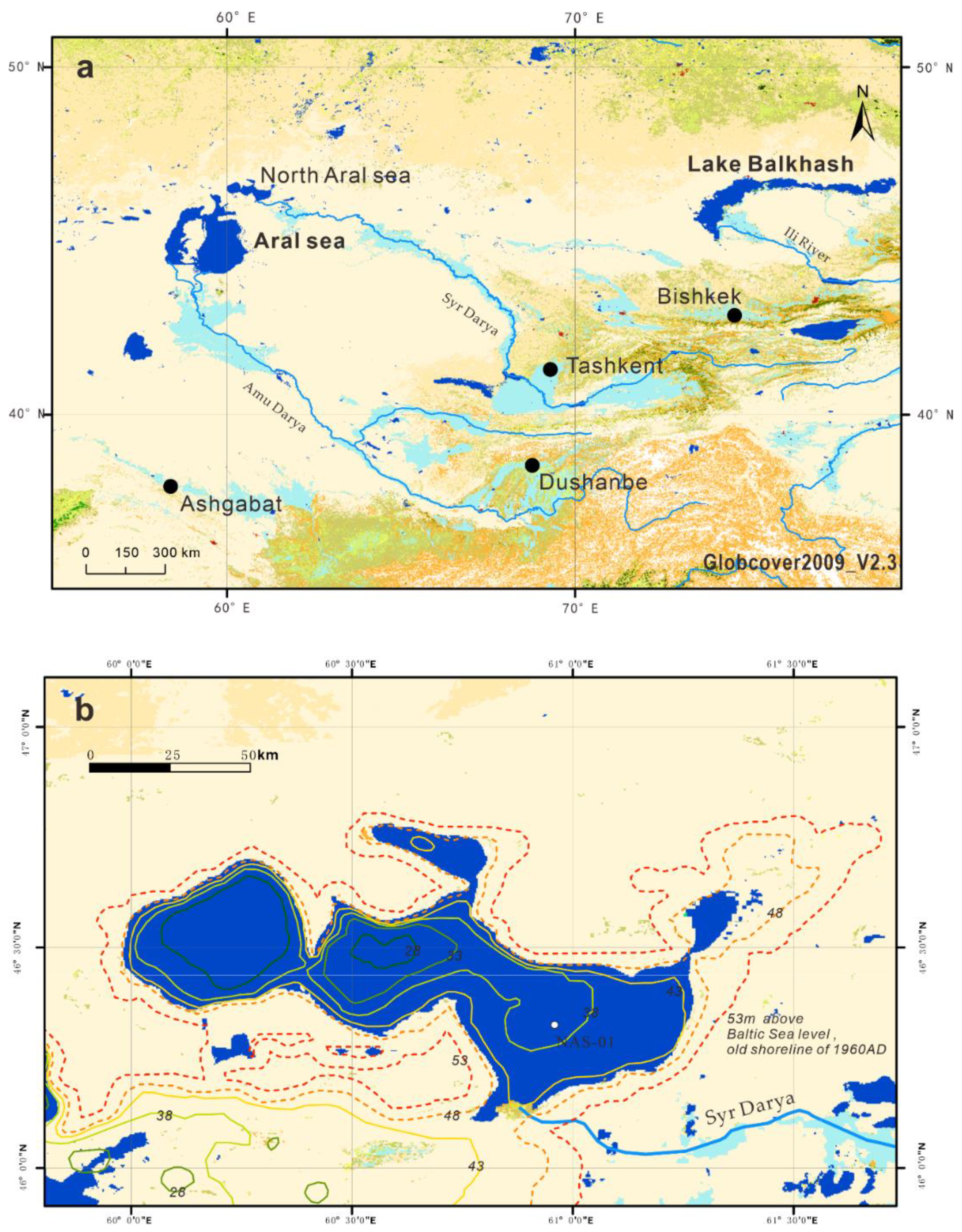

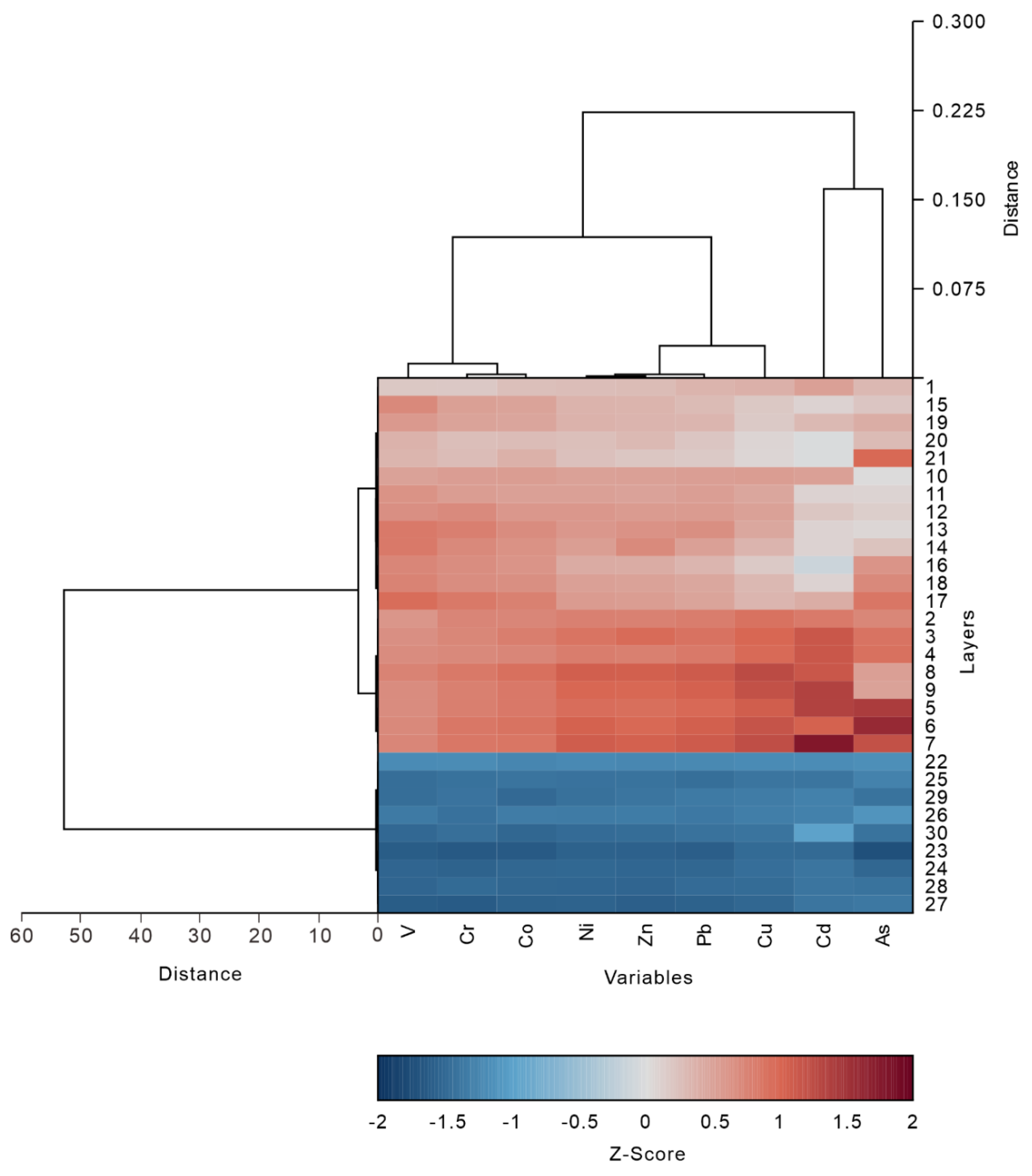

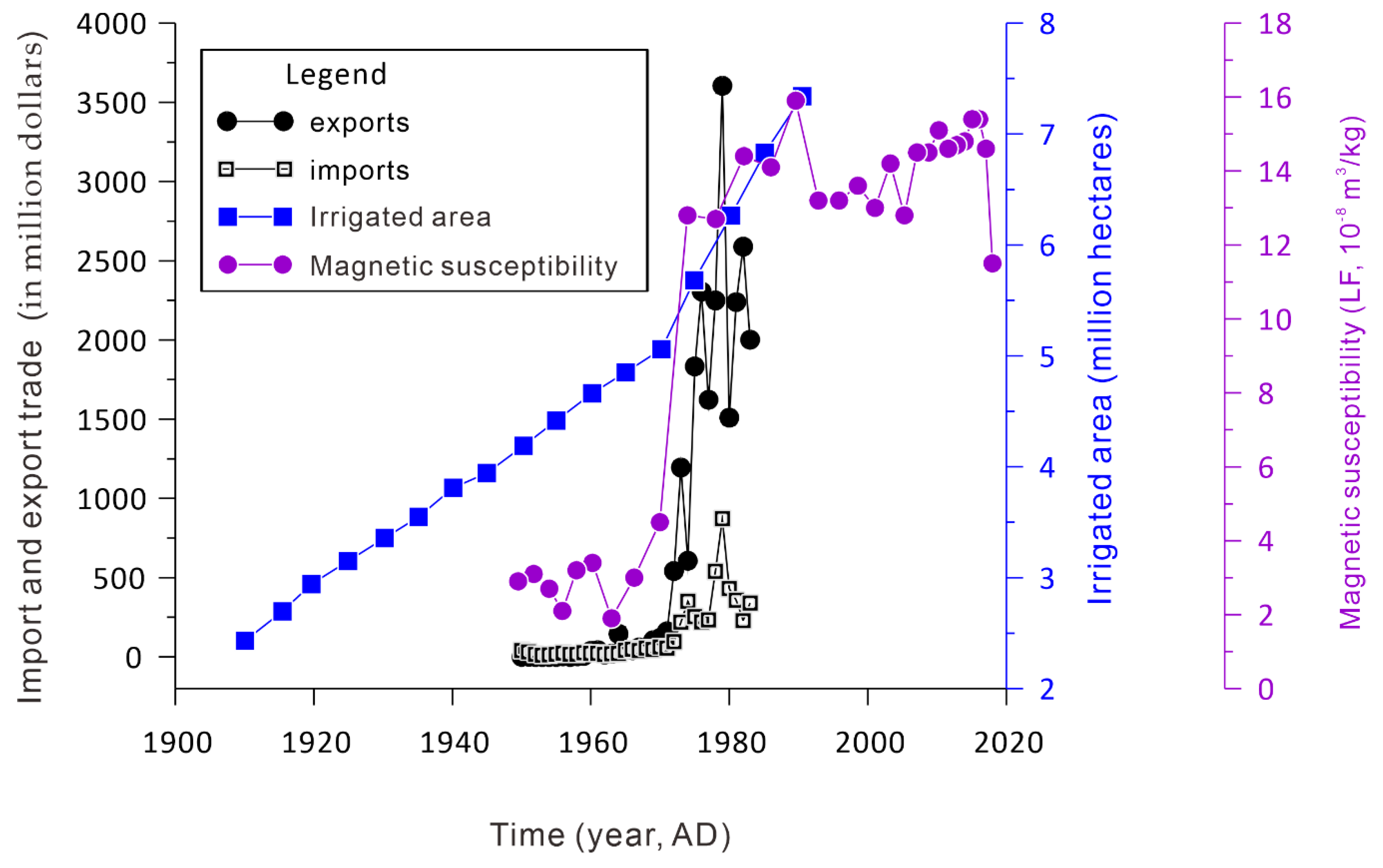
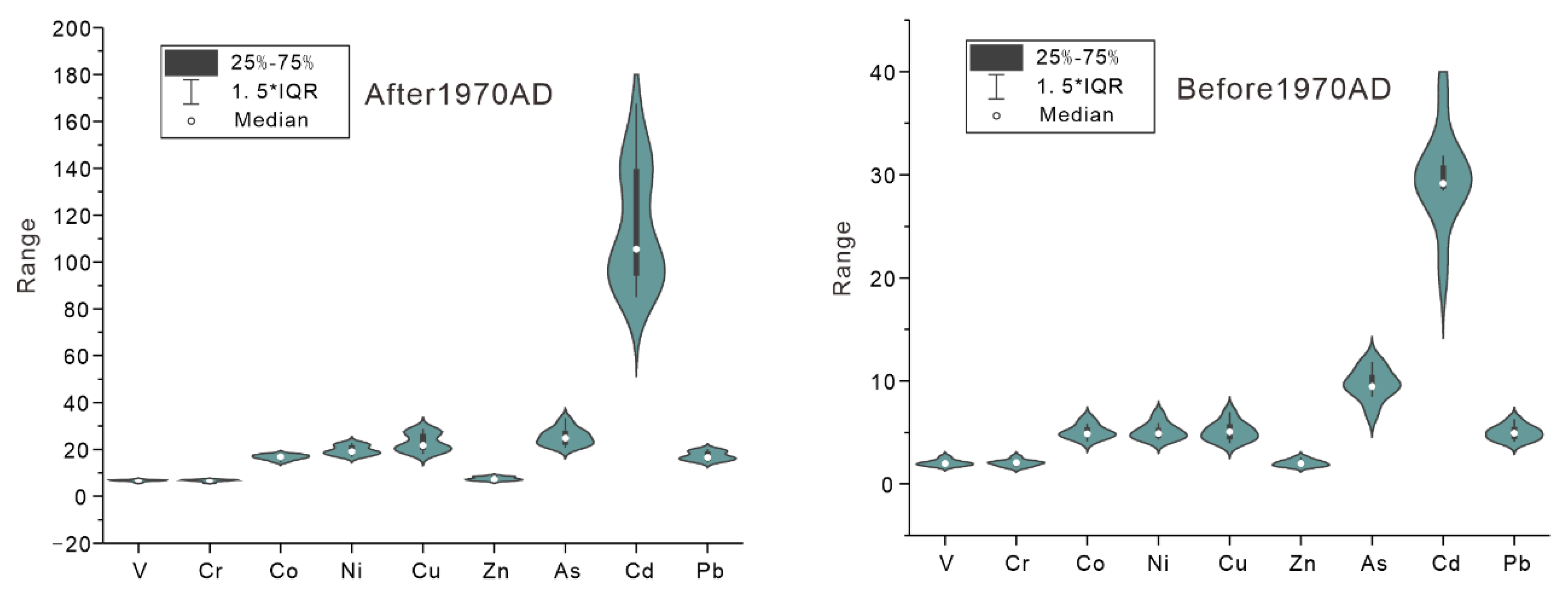
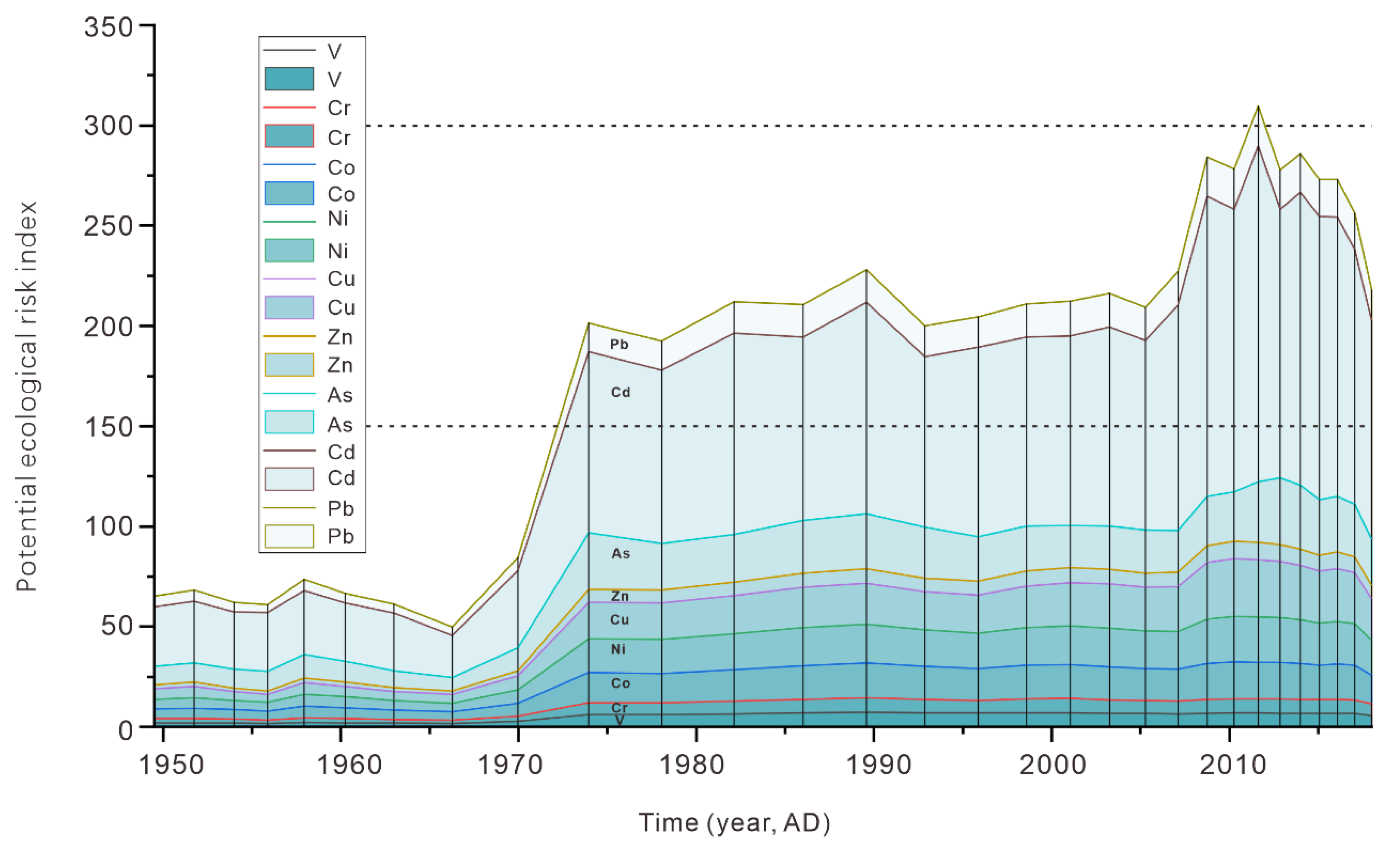
| Er | Classification | RI | Classification |
|---|---|---|---|
| Er <40 | Low | RI < 150 | Low risk |
| 40 ≤ Er < 80 | Moderate | 150≤ RI < 300 | Moderate |
| 80 ≤ Er < 160 | Considerable | 300≤ RI < 600 | Considerable |
| 160 ≤ Er < 320 | High | 600 ≤ RI | high |
| 320 ≤ Er | Very high | - | - |
| Parameters | Range | Minimum | Maximum | Mean | Std. Deviation | |
|---|---|---|---|---|---|---|
| Statistic | Std. Error | |||||
| V (mg/kg) | 97.9 | 29.5 | 127 | 91.6 | 6.94 | 38.0 |
| Cr (mg/kg) | 62.2 | 18.2 | 80.4 | 59.3 | 4.53 | 24.8 |
| Co (mg/kg) | 10.8 | 3.18 | 14.0 | 10.2 | 0.772 | 4.23 |
| Ni (mg/kg) | 33.2 | 7.72 | 40.9 | 27.4 | 2.28 | 12.5 |
| Cu (mg/kg) | 32.3 | 5.16 | 37.5 | 22.8 | 2.11 | 11.5 |
| Zn (mg/kg) | 72.6 | 17.4 | 90.0 | 61.2 | 5.00 | 27.4 |
| As (mg/kg) | 14.6 | 3.78 | 18.3 | 11.4 | 0.797 | 4.37 |
| Cd (mg/kg) | 0.317 | 0.0453 | 0.362 | 0.192 | 0.0176 | 0.0966 |
| Pb (mg/kg) | 18.2 | 4.64 | 22.8 | 15.4 | 1.23 | 6.74 |
| LF (m3/kg) | 14.0 | 1.90 | 15.9 | 10.7 | 0.960 | 5.26 |
| HF (m3/kg) | 13.4 | 2.00 | 15.4 | 10.3 | 0.929 | 5.09 |
| 137Cs (Bq/kg) | 29.3 | 0 | 29.3 | 13.0 | 1.17 | 6.42 |
| Parameters | V | Cr | Co | Ni | Cu | Zn | As | Cd | Pb | LF |
|---|---|---|---|---|---|---|---|---|---|---|
| V | 1 | 0.998 | 0.997 | 0.993 | 0.983 | 0.993 | 0.961 | 0.960 | 0.990 | 0.987 |
| Cr | - | 1 | 0.998 | 0.996 | 0.989 | 0.996 | 0.966 | 0.970 | 0.995 | 0.989 |
| Co | - | - | 1 | 0.998 | 0.991 | 0.998 | 0.973 | 0.975 | 0.995 | 0.990 |
| Ni | - | - | - | 1 | 0.997 | 1.000 | 0.972 | 0.983 | 0.999 | 0.989 |
| Cu | - | - | - | - | 1 | 0.997 | 0.965 | 0.990 | 0.998 | 0.984 |
| Zn | - | - | - | - | - | 1 | 0.969 | 0.981 | 0.999 | 0.989 |
| As | - | - | - | - | - | - | 1 | 0.967 | 0.969 | 0.962 |
| Cd | - | - | - | - | - | - | - | 1 | 0.986 | 0.972 |
| Pb | - | - | - | - | - | - | - | - | 1 | 0.987 |
| LF | - | - | - | - | - | - | - | - | - | 1 |
© 2020 by the authors. Licensee MDPI, Basel, Switzerland. This article is an open access article distributed under the terms and conditions of the Creative Commons Attribution (CC BY) license (http://creativecommons.org/licenses/by/4.0/).
Share and Cite
Liu, W.; Ma, L.; Abuduwaili, J. Historical Change and Ecological Risk of Potentially Toxic Elements in the Lake Sediments from North Aral Sea, Central Asia. Appl. Sci. 2020, 10, 5623. https://doi.org/10.3390/app10165623
Liu W, Ma L, Abuduwaili J. Historical Change and Ecological Risk of Potentially Toxic Elements in the Lake Sediments from North Aral Sea, Central Asia. Applied Sciences. 2020; 10(16):5623. https://doi.org/10.3390/app10165623
Chicago/Turabian StyleLiu, Wen, Long Ma, and Jilili Abuduwaili. 2020. "Historical Change and Ecological Risk of Potentially Toxic Elements in the Lake Sediments from North Aral Sea, Central Asia" Applied Sciences 10, no. 16: 5623. https://doi.org/10.3390/app10165623
APA StyleLiu, W., Ma, L., & Abuduwaili, J. (2020). Historical Change and Ecological Risk of Potentially Toxic Elements in the Lake Sediments from North Aral Sea, Central Asia. Applied Sciences, 10(16), 5623. https://doi.org/10.3390/app10165623





